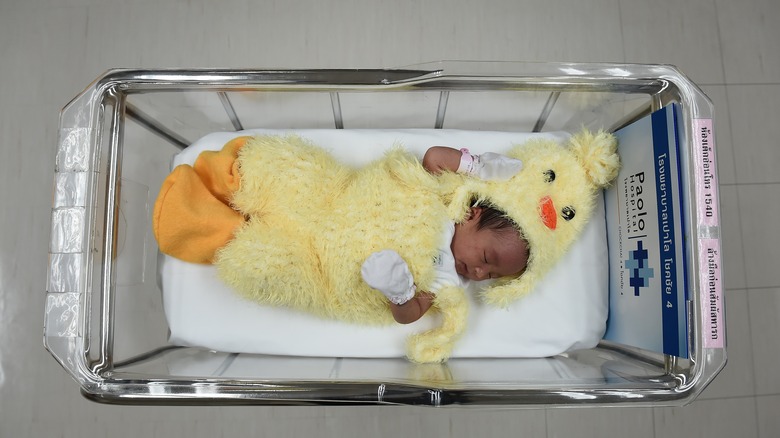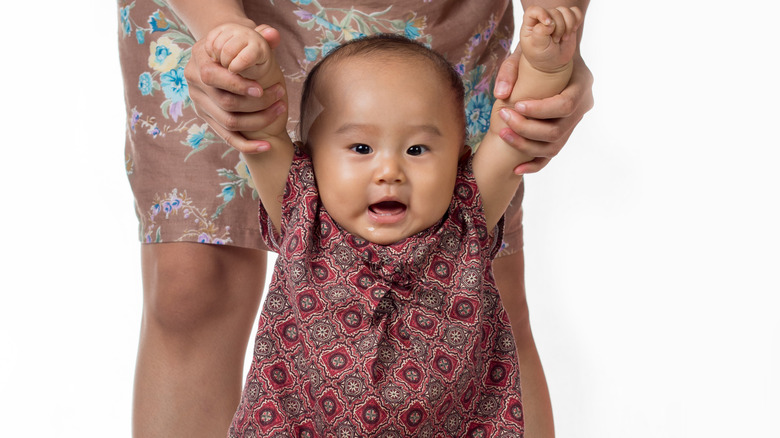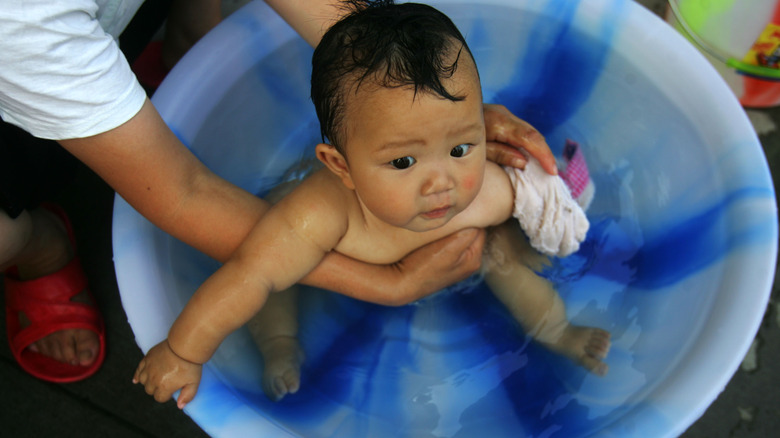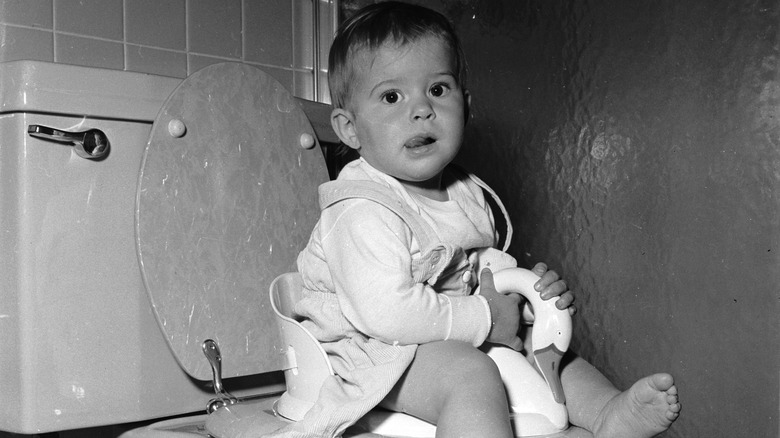Bizarre Things People Used To Believe About Raising Children
Parenting styles have evolved quite a bit over time, thanks to changing attitudes about child rearing. Many of these changes can be attributed to advancements in modern science, as well as psychology.
Some of the child raising techniques employed by parents of days gone by, would horrify the parents of the 21st century. Many parenting techniques that were considered to be the standard just a couple generations ago, do not only seem completely bizarre these days, but in some cases, would be considered borderline child abuse. Here's a look back on how far we've come.
Showing affection could spoil children
In the early 20th century, women were told to suppress their natural instincts and not give babies too much attention, as showering a child with love would spoil the baby. Thanks to this outdated advice, generations of mothers refrained from hugging and kissing their children.
Behaviorist John B. Watson warned of the dangers of showing too much affection to children in his 1928 book, Psychological Care of Infant and Child. According to Watson, "mother love," as he termed it, is "a dangerous instrument which may inflict a never-healing wound, a wound which may make infancy unhappy, adolescence a nightmare, an instrument which may wreck your adult son or daughter's vocational future and their chances for marital happiness."
"Never let them sit on your lap," wrote Watson. "If you must, kiss them once on the forehead when they say good night. Shake hands with them in the morning. Give them a pat on the head if they have made an extraordinary job of a difficult task."
Sleeping babies were supposed to point north
The 19th century was a time of pseudoscience. Popular examples include phrenology, the practice of identifying an individual's personality traits by the shape of their skull, and iridology, which purported to diagnose a person's health by analyzing their irises. During this time, people believed in many implausible ideas that were supposedly rooted in science. And these pseudo-scientific beliefs affected child-rearing in surprising ways.
Dr. George H. Napheys, author of The Physical Life of Woman: Advice to the Maiden, Wife, and Mother, cited a study in his 1878 book by Dr. Henry Kennedy. According to the results of the study, Dr. Napheys told mothers that, in order for their children to be healthy, they should always make sure a baby's sleeping position has the child's head pointing north.
"There are known to be great electrical currents always coursing in one direction around the globe," wrote Dr. Napheys. "In the opinion of Dr. Kennedy there is no doubt that our nervous systems are in some mysterious way connected with this universal agent, as it may be called, electricity."
Drinking while pregnant was totally okay
While today's expectant mothers know that drinking too much alcohol while pregnant can lead to fetal alcohol syndrome, the link between drinking while pregnant and birth defects was not well-known until 1973. Before then, women were known to indulge in alcohol while pregnant.
Not only were women not told to avoid alcohol, but at times it was even recommended that women drink while pregnant. In the 17th century book, The Diseases of Women with Child, and in Child-Bed, Francois Mauriceau told women experiencing morning sickness to drink wine diluted with water. In the book Alcohol, Sex, and Gender in Late Medieval and Early Modern Europe, author L. Martin wrote that medical authorities were "almost unanimous" on including alcohol in a pregnant woman's diet.
In the 15th century, the physician of the Duchess of Bourbon said that the "proper drink" of pregnant women "is white wine or red wine of thin consistency with a bouquet and notably hot and dry." He further said that pregnant women should stick to wine and "shun the use of water."
Even kids drank alcohol
Not only did pregnant women drink alcohol, but in many cases they allowed their children to imbibe it as well. Colonial Americans believed that alcohol had many health benefits. Alcohol was such a common beverage that Harvard had its own brewery in the 17th century and students would frequently make use of its offerings. Many children drank alcohol, although it was typically watered down.
According to Susan Cheever, author of Drinking in America, Our Secret History, by the 1820s, Americans consumed more than three times as much alcohol as they do today. "American drinking was out of control," wrote Cheever. "Children drank before school, during school, at recess, and after school."
Babies weren't allowed to crawl
During the American colonial period, children were viewed as "miniature adults" and were made to grow up quickly.
Cradles were long and narrow. It was believed that if a child could not curl up on their side, they would instead stretch their legs and strengthen them, preparing them to walk at a young age. Crawling was discouraged as it was viewed as "animalistic." Babies were dressed in long gowns that prevented them from crawling. The skirts would extend several inches beyond the ends of their legs.
To help children learn to walk sooner, adults would attach cords to their clothes to guide them and keep them from sitting down. Young children were also put into walking stools which would force them to stay on their legs for long periods of time.
Mothers were blamed for everything
Mothers were held personally responsible for everything from a baby's health to its appearances. Many of the things a mother could do wrong were based on how she felt and what she looked at. It was thought that a mother who looked at ugly things while pregnant would make her baby ugly. It was also believed that mothers could affect their baby's health with their attitudes.
In a 1916 baby parenting book called The Mother and her Child written by husband and wife doctor couple, William and Lena Sadler, "angry" mothers were blamed for giving their babies colic. Nagging was also not permitted as it could make a woman's milk dry up.
An 1877 book, Advice to a Wife, written by Pye Henry Chavasse, warned mothers not to nurse beyond a baby's ninth month. Breastfeeding longer than that could supposedly give babies brain disease and make the nursing mother go blind.
Babies were bathed in lard
While people today tend to take a bath or shower several times a week, this is a relatively recent development. The importance of hygiene wasn't truly understood until the late 19th century. By the turn of the 20th century, attitudes towards hygiene were changing, but parents were still given some strange advice on how to bathe newborns.
Parenting advice books from that time told new parents to smear their babies in fats like lard, olive oil, or butter. According to Chavasse's Advice to a Mother, grease was needed in order to remove the "waxy coating" that babies are born with. Parents were not supposed to bathe their children with soap and water until they were around one week old.
Watch out for the wet nurse
It was quite common for well-off families to hire a wet nurse to save the new mother from the indignities of breast feeding. Even women who nursed their babies themselves were likely to hire someone to help care for their child.
These nursemaids were often from less well-to-do families and, as such, were viewed with suspicion by the upper echelons of society. Parenting manuals from the early 20th century warned parents to be wary of the women watching their children. In The Rural Efficiency Guide, mothers were cautioned that they "cannot be too watchful of nursemaids" and that these "vicious" women might not provide their baby with adequate care.
The Mother and Her Child made the class differences of the early 20th century painfully apparent, suggesting to nurses that they should not demand too much money as they are being given the "honor" of living in an upper class home.
Infants were potty trained
In the late 19th and early 20th centuries parents tried to potty train their infants. Part of this was for practical purposes: in the days before disposable diapers, cleaning soiled cloth diapers was a time-consuming (and unpleasant) task. It was also thought that regulating a baby's eating and sleeping patterns would teach an infant that the world did not revolve around them.
William and Lena Sadler's 1916 manual, The Mother and Her Child provided instructions on how to potty train infants. Mothers were told to begin this training as early as four months by holding babies over the "receptacle" at the same time each day. By eight or nine months, the Sanders said that "urination can be controlled" and that "by the end of the first year" a baby would be completely potty trained.
Frederick H. Bartlett wrote in The Care and Feeding of Infants that if a baby did not adhere to the schedule, a soap stick should be inserted in their rectum. He wrote that "the movement will usually occur under this stimulus. If you keep this up with regularity, a daily bowel movement will probably result."
Car seats didn't exist
Seat belts in cars did not become common until the 1950s and, even then, they were considered to be optional accessories and were not required to be used by passengers. These days, extra precautions are taken for infants and children riding in cars, and children under a certain height are required to have special seats. For much of the 20th century, however, riding in a car was a risky endeavor — especially for children.
With no restraints, children were not secured in the car. A 1935 pamphlet issued by the U.S. Department of Health and Services told parents that, if they were going to travel, to place the baby in a "market basket" with a "handle low enough to hold him safely inside." A small hammock was to be used on car rides.
Trust yourself
While it can be tempting to binge read all the parenting advice you can get your hands on, remember that parenting techniques are always changing. One of the most priceless bits of advice comes from Dr. Benjamin Spock, author of the manual Baby and Child Care.
In his bestselling book, Dr. Spock reminds parents that they should listen to their instincts. "Trust yourself," writes Dr. Spock. "You know more than you think you do."










